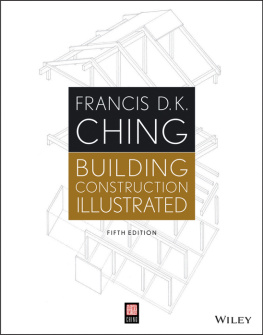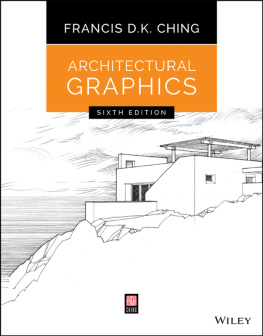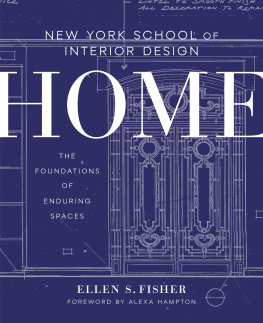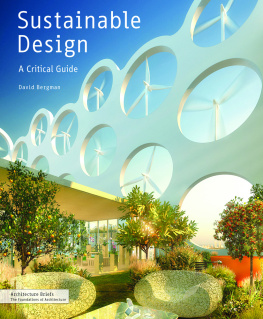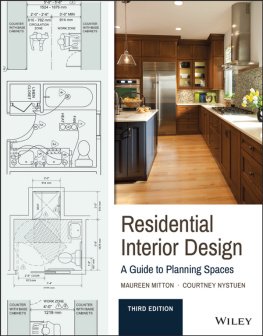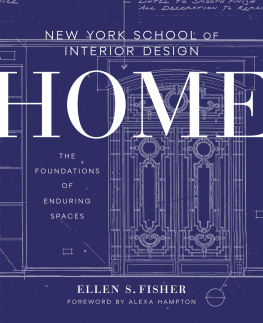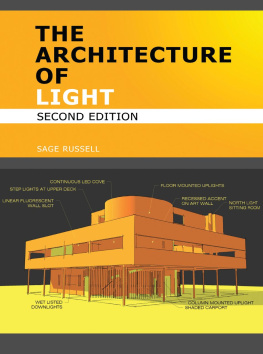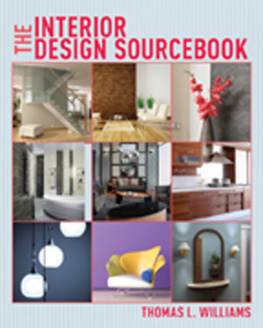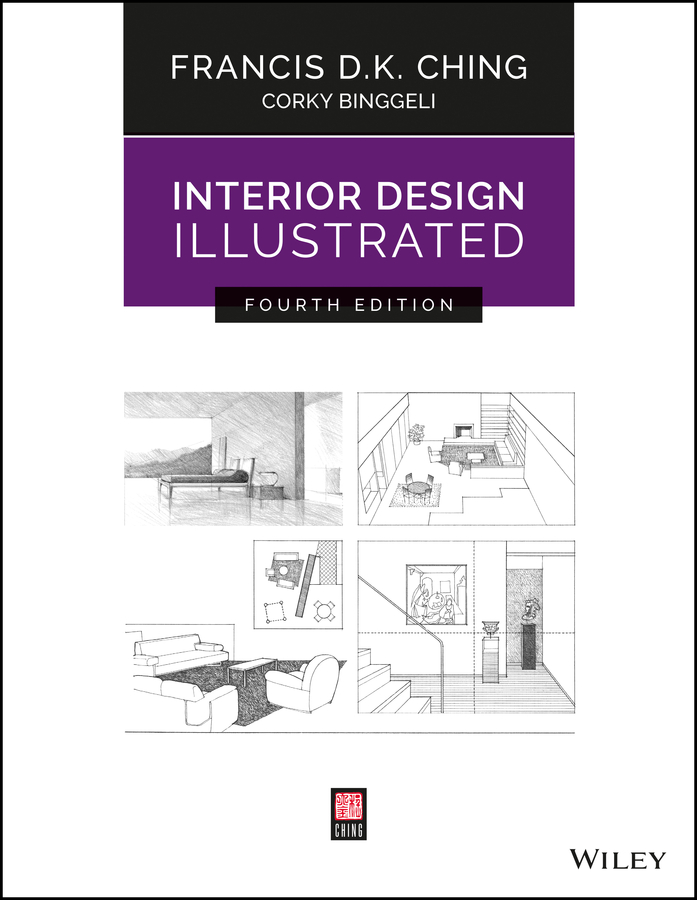
Cover image: Courtesy of Francis D. K. Ching
Cover design: Wiley
Copyright 2018 by John Wiley & Sons, Inc. All rights reserved.
Published by John Wiley & Sons, Inc., Hoboken, New Jersey.
Published simultaneously in Canada.
No part of this publication may be reproduced, stored in a retrieval system, or transmitted in any form or by any means, electronic, mechanical, photocopying, recording, scanning, or otherwise, except as permitted under Section 107 or 108 of the 1976 United States Copyright Act, without either the prior written permission of the Publisher, or authorization through payment of the appropriate per-copy fee to the Copyright Clearance Center, 222 Rosewood Drive, Danvers, MA 01923, (978) 7508400, fax (978) 6468600, or on the web at www.copyright.com. Requests to the Publisher for permission should be addressed to the Permissions Department, John Wiley & Sons, Inc., 111 River Street, Hoboken, NJ 07030, (201) 7486011, fax (201) 7486008, or online at www.wiley.com/go/permissions.
Limit of Liability/Disclaimer of Warranty: While the publisher and author have used their best efforts in preparing this book, they make no representations or warranties with respect to the accuracy or completeness of the contents of this book and specifically disclaim any implied warranties of merchantability or fitness for a particular purpose. No warranty may be created or extended by sales representatives or written sales materials. The advice and strategies contained herein may not be suitable for your situation. You should consult with a professional where appropriate. Neither the publisher nor the author shall be liable for damages arising herefrom.
For general information about our other products and services, please contact our Customer Care Department within the United States at (800) 7622974, outside the United States at (317) 5723993 or fax (317) 5724002.
Wiley publishes in a variety of print and electronic formats and by print-on-demand. Some material included with standard print versions of this book may not be included in e-books or in print-on-demand. If this book refers to media such as a CD or DVD that is not included in the version you purchased, you may download this material at http://booksupport.wiley.com. For more information about Wiley products, visit www.wiley.com.
Library of Congress Cataloging-in-Publication Data:
Ching, Francis D. K., 1943- | Binggeli, Corky
Interior design illustrated / by Francis D. K. Ching, Corky Binggeli.4th ed.
p. cm.
Includes bibliographical references and index.
LCCN 2017036457 | ISBN 9781119377207 (paperback) | ISBN 9781119468578 (ePDF)
ISBN 9781119468530 (ePub)
Interior architecture. | Space (Architecture) | Interior DecorationHistory21st century.
BISAC: ARCHITECTURE / Interior Design / General.
LCC NA2850 .C45 2018 | DDC 729dc23 LC record available at https://lccn.loc.gov/2017036457
Preface
We spend the majority of our lives indoors, in the interior spaces created by the structures and shells of buildings. These spaces provide the physical context for much of what we do, and give substance and life to the architecture that houses them. This introductory text is a visual study of the nature and design of these interior settings.
The purpose of this primer is to introduce to students of interior design those fundamental elements that make up our interior environments. It outlines the characteristics of each element and presents the choices we have in selecting and arranging them into design patterns. In making these choices, emphasis is placed on basic design principles and how design relationships determine the functional, structural, and aesthetic qualities of interior spaces.
This fourth edition retains the organizational scheme of the third edition, with text and illustrations updated and added to cover sustainability standards, resource usage, and recent developments in the design of interior spaces. The section on lighting reflects current design practice, lamp and fixture styles, especially the growing use of light-emitting diodes (LEDs). The coverage of furnishings responds to changes in the work environment. New residential topics include accessory dwelling units (ADUs) and touchless kitchen faucets, among others. Standards and codes incorporate current International Code Council (ICC) and Americans with Disabilities Act (ADA) requirements. Finally, the Bibliography and Glossary have been updated.
This exploration of the ways and means of developing interior spaces begins with space itself, for it is the prime material with which the interior designer must work.
: Interior Space proceeds from a general discussion of architectural space to the particular characteristics of interior space in three dimensions and introduces the components of a building. The adaptive reuse of existing buildings and movement within buildings are addressed.
: Interior Design outlines a method for translating programmatic needs and requirements into three-dimensional design decisions. Interior architecture is introduced, as well as designing in existing buildings and historic preservation. The use of artisanal products and resiliency is addressed. Topics including design for an aging population and for children are covered, as are coworking spaces. Sustainable design rating systems and standards are updated as well. Three-dimensional printing and virtual reality are also introduced.
: A Design Vocabulary explores the fundamental elements and principles of visual design and applies each of them to the unique field of interior design. New information on photoreceptors in the mammalian retina and strategies for creating emphasis by using lighting and color together are presented.
: Interior Building Elements describes the major categories of interior elements and discusses how each affects the functional and aesthetic development of interior spaces. New options in glass wall systems and the importance of views of nature are introduced. Coverage of elevators is expanded to include machine-room-less (MRL) elevators.
: Interior Environmental Systems outlines the environmental control systems that must be integrated with a building's structure and the layout of the interior spaces. The role of the interior designer in educating the client about building systems is addressed. Updates in the types of plumbing fixtures are added, as is information on wireless electrical systems. Information on problems with flame retardant chemicals is also included.
: Lighting and Acoustics addresses the lively and ever-present interaction of light and sound with the interior environment. Recent changes in the process of lighting design and daylighting are addressed, including the increasing use of LEDs and lighting controls. Changes in the use of incandescent, fluorescent, and high-intensity discharge (HID) lamps are also covered. Current changes in the lighting industry are discussed. The integration of acoustical design into interior design practices is included, as is the importance of acoustic privacy and sound masking.
: Finish Materials introduces the palette used by interior designers to modify the architectural elements of interior spaces. Consideration of functional criteria is expanded to include hydrophobic properties. Finish flooring covers electrostatic discharge (ESD) issues. Coverage of bamboo flooring, terrazzo, and carpet cushions is expanded, and information on carpet recycling is updated. Coverage of composite wood panels, particleboard, medium-density fiberboard (MDF), and vacuum-formed 3D panel products and solid surfacing materials is added, and information on lead paint is expanded. Ceiling finish coverage now includes canopies and clouds.
Next page


